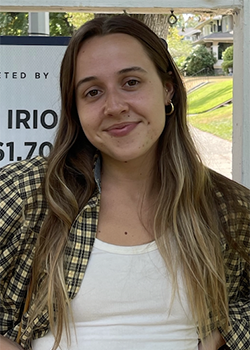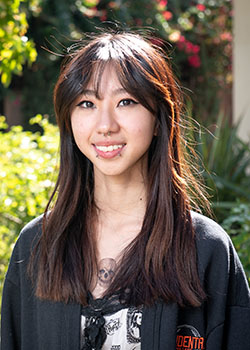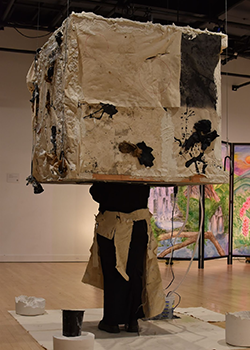Meet some of our Art & Art History majors.

Mckenzie Locke
Hometown: Los Angeles, CA
Major: Art History, minor: Urban and Environmental Policy
What was your motivation to take Art History? Was there a specific inspirational moment or experience?
My high school art history teacher, Ms. Newman, inspired my love for the subject. I enjoyed the amount of exciting, revelatory discussions about the relationships between formal and contextual elements within an art piece. When I arrived at Oxy, I felt really engaged by the variety of ways that each professor in the department shaped my knowledge about the subject. And I felt compelled by discussions surrounding contemporary art that redefined what I had initially considered art and art history.
Can you describe your working relationships with art professors? Are there any standout classes you've taken?
Every time I take a new art history class, it stands out from the previous one I've taken. There are two that have felt particularly remarkable to me because they were both very participatory. One was the Seminar in Art History: Performance, Embodiment and the Dematerialization of Contemporary Art, which was composed of about 10 students and taught by Professor Amy Lyford. We collaborated on an art project that involved guidance from artists Arleene Correa Valencia, Ronald Rael, and Ana Teresa Fernández, which we then installed across the Oxy campus. The Curatorial Seminar in Art History was also fantastic. Every week, Professor Nicholas Barlow organized visits to museum archives throughout Los Angeles or welcomed a guest lecturer to speak about their work as art collectors, artists, or writers. Both of these classes involved a lot of engagement and a lot of fun in the classroom environment.
When I arrived at Oxy, I felt really engaged by the variety of ways that each professor in the department shaped my knowledge about the subject.
Have you taken part in any student research opportunities at Oxy or elsewhere? Or, if applicable, can you describe your senior comps project?
I felt really lucky to complete research with Professor Amy Lyford on her new book. In particular, I learned a lot about the elaborate process of securing image rights. In regard to the second question, my senior comps project is about an installation initiated by a collective of over 12 artists in response to the March 11, 2011 triple disaster in Fukushima, Japan. The installation is titled "Don't Follow the Wind" and is located in Futaba. It includes collaboration with former residents and has been largely inaccessible until quite recently due to radiation guidelines. My project discusses the evolving spatial and temporal relationship between the installation, its environment, and Futaba residents.
What do you find most compelling about studying Art History?
What I find most compelling about studying Art History is its encouragement of noticing and exploring fine details. It has shown me the importance of patience that comes with studying and understanding an art piece.
Do you have advice for a student considering a major in Art History?
My advice would be to take classes from as many of the Art History professors as possible before deciding. They're all wonderful and take different approaches to teaching the subject. Also, Art History classes are often full of students who don't necessarily want to study Art History as their major, and that brings a lot of different perspectives to one environment. I would recommend taking several other classes in a subject you love besides those in Art History because it will broaden your understanding of Art History and allow you to find many intersections between the two subjects.

Alex Kawawaki
Hometown: Nagasaki, Japan
Major: Art History
What was your motivation to major in Art History?
I have always been drawn to the arts through the expansive ways artists have utilized mediums to illustrate past, present and future realities, and the strength of art’s resonance within the viewer. When I came to Oxy, I was undecided, split between Studio Art and Art History; I think a primary motivation in majoring in Art History is my habit of preserving, and the ways its intentional practice can be illuminating.
Can you describe your working relationships with art professors? Are there any standout classes you’ve taken?
Professor Amy Lyford has been a wonderful mentor throughout my experience at Oxy. Her deep knowledge of performance art, gender studies, and contemporary art and her active engagement with cultivating critical discussions have been vital in my learning. My favorite class I’ve taken is Professor Lyford’s “Performance, Embodiment and the Dematerialization of Contemporary Art.” The final project was collaborative, and I had a lot of fun implementing historical narratives and practices into an art project!
I am grateful to have been able to learn among and be supported by peers who are deeply passionate about art.
Have you taken part in any student research opportunities at Oxy or elsewhere?
I had the opportunity to take part in the Summer Research Program during my junior year, where under the guidance of Professor Lyford, I researched women-identifying artists’ use of body art to subvert and explore Western constructions of womanhood. This experience allowed me to develop my research and archival practices, which helped me greatly as I continued with the topic for my senior comps project.
Do you have any advice for a student considering a major in Art History?
Talk to your professors, and take classes that intrigue you! Media Arts & Culture (MAC) is also an amazing department that provides another perspective into what we may consider ‘art history.’ Professor Vivian Lin’s “Topics in Media Representation” class and “Participatory (Documentary) Practices” have been a guide and inspiration in my interest within archival research. Even though I am not a MAC major, I have been lucky enough to have her as a mentor by taking her classes and connecting through shared interests!
What is the “vibe” of the Art & Art History department?
I would say the ‘vibe’ of the department is inspiring, relaxed, and like a network of capillaries or galaxies. It’s a fairly small department, but the burst of creativity and knowledge is specific and unique to each individual, and I am grateful to have been able to learn among and be supported by peers who are deeply passionate about art.

Jamie Martinez
Hometown: Brookline, MA
Major: Studio art, minors: education, politics
What was your motivation to major in Studio Art?
I did not join the Studio Art major until the beginning of my junior year at Oxy. After taking a few classes within the department, I realized how I could adopt a more transdisciplinary approach in this department, both in my in-class work and outside the classroom. Working as a student worker at OXY ARTS and as a shop technician at Mullin Studios definitely cemented how I have continued with this approach throughout my time at Oxy.
Can you describe your working relationships with art professors?
The Mullin Studio Manager, Chris Wawrinofsky, has been instrumental in the development of my technical and conceptual art-making skills throughout my time at Oxy. The work he does for Oxy is what makes the work of the Art & Art History department, students and professors alike, possible.
After Oxy, I want to continue working in the development of community programming, specifically cultivating broader accessibility to artists, art spaces, and materials.
What do you find most compelling about studying Studio Art?
Studying Studio Art has helped me continue to strengthen my own practice, has expanded my repertoire of mediums and techniques to work in, and has given me the opportunity to develop relationships with other folks developing their own work/practice.
What are your ambitions post-Oxy?
After Oxy, I want to continue working in the development of community programming, specifically cultivating broader accessibility to artists, art spaces, and materials. My work with OXY ARTS has definitely directly shaped my skill sets in this regard.
Do you have any advice for a student considering a major in Studio Art?
If you are considering majoring in Studio Art, I would recommend taking studio art classes as early on in your undergraduate studies as possible. Take one (or multiple) of the required entry level courses – ARTS 102: Painting Fundamentals, ARTS 105: Printmaking Fundamentals, or ARTS 103: Sculpture Fundamentals. Taking these classes helped me figure out that I wanted to join the major, and, should you not find yourself interested in the major, you will have at least completed your CPFA requirement!
To see more Meet Our Majors profiles, visit the main page.
